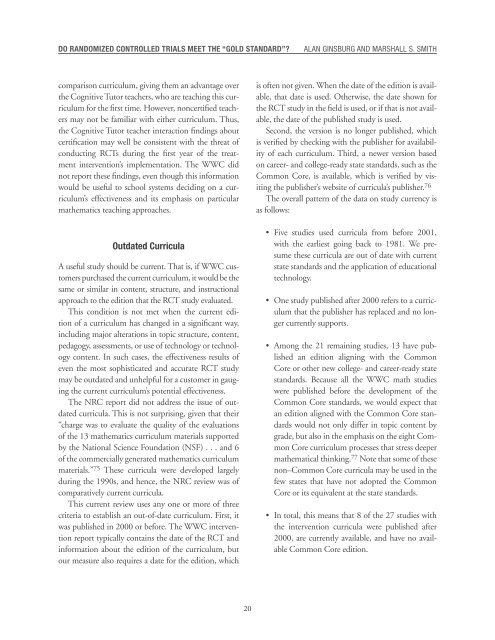Do Randomized Controlled Trials Meet the “Gold Standard”?
Do-randomized-controlled-trials-meet-the-gold-standard
Do-randomized-controlled-trials-meet-the-gold-standard
You also want an ePaper? Increase the reach of your titles
YUMPU automatically turns print PDFs into web optimized ePapers that Google loves.
DO RANDOMIZED CONTROLLED TRIALS MEET THE “GOLD STANDARD”?<br />
ALAN GINSBURG AND MARSHALL S. SMITH<br />
comparison curriculum, giving <strong>the</strong>m an advantage over<br />
<strong>the</strong> Cognitive Tutor teachers, who are teaching this curriculum<br />
for <strong>the</strong> first time. However, noncertified teachers<br />
may not be familiar with ei<strong>the</strong>r curriculum. Thus,<br />
<strong>the</strong> Cognitive Tutor teacher interaction findings about<br />
certification may well be consistent with <strong>the</strong> threat of<br />
conducting RCTs during <strong>the</strong> first year of <strong>the</strong> treatment<br />
intervention’s implementation. The WWC did<br />
not report <strong>the</strong>se findings, even though this information<br />
would be useful to school systems deciding on a curriculum’s<br />
effectiveness and its emphasis on particular<br />
ma<strong>the</strong>matics teaching approaches.<br />
Outdated Curricula<br />
A useful study should be current. That is, if WWC customers<br />
purchased <strong>the</strong> current curriculum, it would be <strong>the</strong><br />
same or similar in content, structure, and instructional<br />
approach to <strong>the</strong> edition that <strong>the</strong> RCT study evaluated.<br />
This condition is not met when <strong>the</strong> current edition<br />
of a curriculum has changed in a significant way,<br />
including major alterations in topic structure, content,<br />
pedagogy, assessments, or use of technology or technology<br />
content. In such cases, <strong>the</strong> effectiveness results of<br />
even <strong>the</strong> most sophisticated and accurate RCT study<br />
may be outdated and unhelpful for a customer in gauging<br />
<strong>the</strong> current curriculum’s potential effectiveness.<br />
The NRC report did not address <strong>the</strong> issue of outdated<br />
curricula. This is not surprising, given that <strong>the</strong>ir<br />
“charge was to evaluate <strong>the</strong> quality of <strong>the</strong> evaluations<br />
of <strong>the</strong> 13 ma<strong>the</strong>matics curriculum materials supported<br />
by <strong>the</strong> National Science Foundation (NSF) . . . and 6<br />
of <strong>the</strong> commercially generated ma<strong>the</strong>matics curriculum<br />
materials.” 75 These curricula were developed largely<br />
during <strong>the</strong> 1990s, and hence, <strong>the</strong> NRC review was of<br />
comparatively current curricula.<br />
This current review uses any one or more of three<br />
criteria to establish an out-of-date curriculum. First, it<br />
was published in 2000 or before. The WWC intervention<br />
report typically contains <strong>the</strong> date of <strong>the</strong> RCT and<br />
information about <strong>the</strong> edition of <strong>the</strong> curriculum, but<br />
our measure also requires a date for <strong>the</strong> edition, which<br />
is often not given. When <strong>the</strong> date of <strong>the</strong> edition is available,<br />
that date is used. O<strong>the</strong>rwise, <strong>the</strong> date shown for<br />
<strong>the</strong> RCT study in <strong>the</strong> field is used, or if that is not available,<br />
<strong>the</strong> date of <strong>the</strong> published study is used.<br />
Second, <strong>the</strong> version is no longer published, which<br />
is verified by checking with <strong>the</strong> publisher for availability<br />
of each curriculum. Third, a newer version based<br />
on career- and college-ready state standards, such as <strong>the</strong><br />
Common Core, is available, which is verified by visiting<br />
<strong>the</strong> publisher’s website of curricula’s publisher. 76<br />
The overall pattern of <strong>the</strong> data on study currency is<br />
as follows:<br />
• Five studies used curricula from before 2001,<br />
with <strong>the</strong> earliest going back to 1981. We presume<br />
<strong>the</strong>se curricula are out of date with current<br />
state standards and <strong>the</strong> application of educational<br />
technology.<br />
• One study published after 2000 refers to a curriculum<br />
that <strong>the</strong> publisher has replaced and no longer<br />
currently supports.<br />
• Among <strong>the</strong> 21 remaining studies, 13 have published<br />
an edition aligning with <strong>the</strong> Common<br />
Core or o<strong>the</strong>r new college- and career-ready state<br />
standards. Because all <strong>the</strong> WWC math studies<br />
were published before <strong>the</strong> development of <strong>the</strong><br />
Common Core standards, we would expect that<br />
an edition aligned with <strong>the</strong> Common Core standards<br />
would not only differ in topic content by<br />
grade, but also in <strong>the</strong> emphasis on <strong>the</strong> eight Common<br />
Core curriculum processes that stress deeper<br />
ma<strong>the</strong>matical thinking. 77 Note that some of <strong>the</strong>se<br />
non–Common Core curricula may be used in <strong>the</strong><br />
few states that have not adopted <strong>the</strong> Common<br />
Core or its equivalent at <strong>the</strong> state standards.<br />
• In total, this means that 8 of <strong>the</strong> 27 studies with<br />
<strong>the</strong> intervention curricula were published after<br />
2000, are currently available, and have no available<br />
Common Core edition.<br />
20



